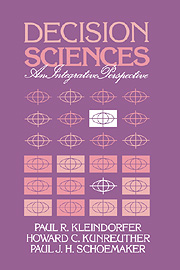Book contents
- Frontmatter
- Contents
- Dedication
- Preface
- Part I Introduction
- Part II Individual decision making
- Part III Multiperson decision making
- Part IV Epilogue
- Appendixes
- Appendix A Expected utility theory with examples
- Appendix B Multi-attribute value functions: the case of certainty
- Appendix C Multi-attribute expected utility theory
- Sources
- Index
Appendix C - Multi-attribute expected utility theory
Published online by Cambridge University Press: 05 June 2012
- Frontmatter
- Contents
- Dedication
- Preface
- Part I Introduction
- Part II Individual decision making
- Part III Multiperson decision making
- Part IV Epilogue
- Appendixes
- Appendix A Expected utility theory with examples
- Appendix B Multi-attribute value functions: the case of certainty
- Appendix C Multi-attribute expected utility theory
- Sources
- Index
Summary
This appendix illustrates how multi-attribute utility (MAU) theory can be applied to risky or uncertain alternatives. Since the process involved is somewhat intricate, we shall lay the problem out in discrete steps and stages as follows.
Determine a reasonable family (or class) of utility functions (using explicit assumptions about the person's preferences or just proceeding purely pragmatically).
Using a set of historical revealed preferences or hypothetical preferences questions, determine a number of equations and inequalities.
Using eyeball techniques, regression analysis, algebraic manipulations, and so forth, interpret these revealed preferences in terms of the parameters of a particular utility function within the assumed class.
In our experience, the richer the set of revealed preferences in (2), the better the chances are of understanding the decision maker's preference structure.
The remainder of this appendix offers a numerical illustration of the steps involved and concludes with the general case.
Numerical illustration
Problem: How to choose consistently among two job offers (Job Ā, Job B) characterized as risk profiles along three dimensions.
Dimensions: x1 = job satisfaction (on a scale from 0 to 100)
x2 = average present value of annual salary over first three years (ranging from $20,000 to $40,000)
x3 = quality of living in job location (on a scale from 0 to 10)
Objective: Construct a utility function U(x1,x2,x3) such that E[U{x1{Ā), x2(Ā), x3(Ā)}] > E[U{x1{B), x2(B), x3(B)}] if and only if Job Ā is preferred to Job B.
- Type
- Chapter
- Information
- Decision SciencesAn Integrative Perspective, pp. 421 - 428Publisher: Cambridge University PressPrint publication year: 1993



